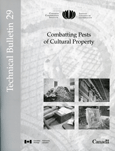The most effective method of monitoring insects is through the use of "sticky" traps, which capture insects, allowing identification, locations, and (sometimes) quantities to be determined.
Books and products we recommend:
 CCI Tech Bulletin #13 Controlling Vertebrate Pests in Museums by Thomas J.K. Strang and John E. Dawson
CCI Tech Bulletin #13 Controlling Vertebrate Pests in Museums by Thomas J.K. Strang and John E. Dawson
Examines the detrimental affect that rodents have on museum collections. Vertebrate animals can soil or destroy artifacts. Prompt identification of the pest and the use of suitable methods to control it are essential. In most cases, non-chemical methods can be used to control vertebrate pests in museums; chemical methods are also discussed.
| Controlling Vertebrate Pests in Museums | $12.00 |
 CCI Tech Bulletin # 15 Solving Museum Insect Problems: Chemical Control by John E. Dawson and revised by Thomas J.K. Strang
CCI Tech Bulletin # 15 Solving Museum Insect Problems: Chemical Control by John E. Dawson and revised by Thomas J.K. Strang
Intended to help museum staff understand commercial pest control operations. It describes chemical methods of controlling insects, and includes information on regulations, modes of action, and application methods necessary for the safe use of insecticides. A detailed guide helps in decision-making about the appropriate chemical method of control.
| Solving Museum Insect Problems: Chemical Control | $26.00 |
 CCI Tech Bulletin #29 Combatting Pests of Cultural Property by Tom Strang and Rika Kigawa
CCI Tech Bulletin #29 Combatting Pests of Cultural Property by Tom Strang and Rika Kigawa
Pests can be very destructive to both aesthetic elements and the structural integrity of collections, historic buildings, and objects. Protection against pests requires attention to the collection’s environment, containment, discovery of pests, response to pests, and remediation actions. Reducing loss of value over time is the goal of preventive conservation strategies. Integrated pest management (IPM) practices are part of this process. Having a safe work environment and minimizing adverse effects to objects from chemical exposure is a background concern. Effectiveness of any control procedure or treatment can be measured by reducing the extent and repeated incidence of the problem. Basic pests of collections, and a structured approach to pest reduction activities, are presented. A survey method with remediation activities appropriate to pest infestation findings is given to help start an IPM program for a wide range of collections from outdoor installations to state-of-the art preservation facilities.
| Combatting Pests of Cultural Property | $35.00 |

Vol.1 No.3
Integrated Pest Management
| $5.00 |
Links to related information on other sites:
Insect Traps in Conservation Surveys
http://sul-server-2.stanford.edu/waac/ wn/wn13/wn13-1/wn13-108.html
Insect Monitoring in Museums
http://sul-server-2.stanford.edu/waac/ wn/wn13/wn13-1/wn13-107.html
Monitoring Insect Pests with Sticky Traps (Conserve-O-Gram 3/7) – (An Adobe PDF file)
http://www.cr.nps.gov/museum/publications/ conserveogram/03-07.pdf
